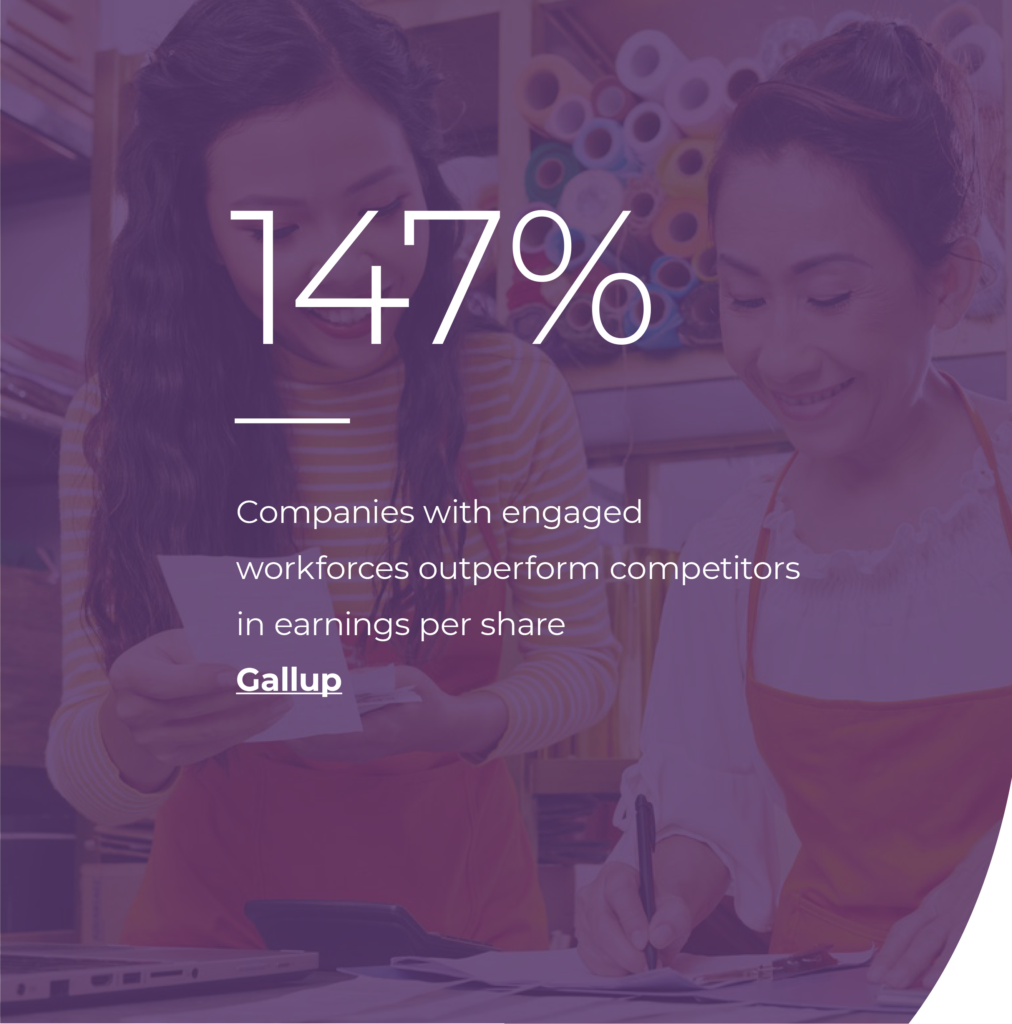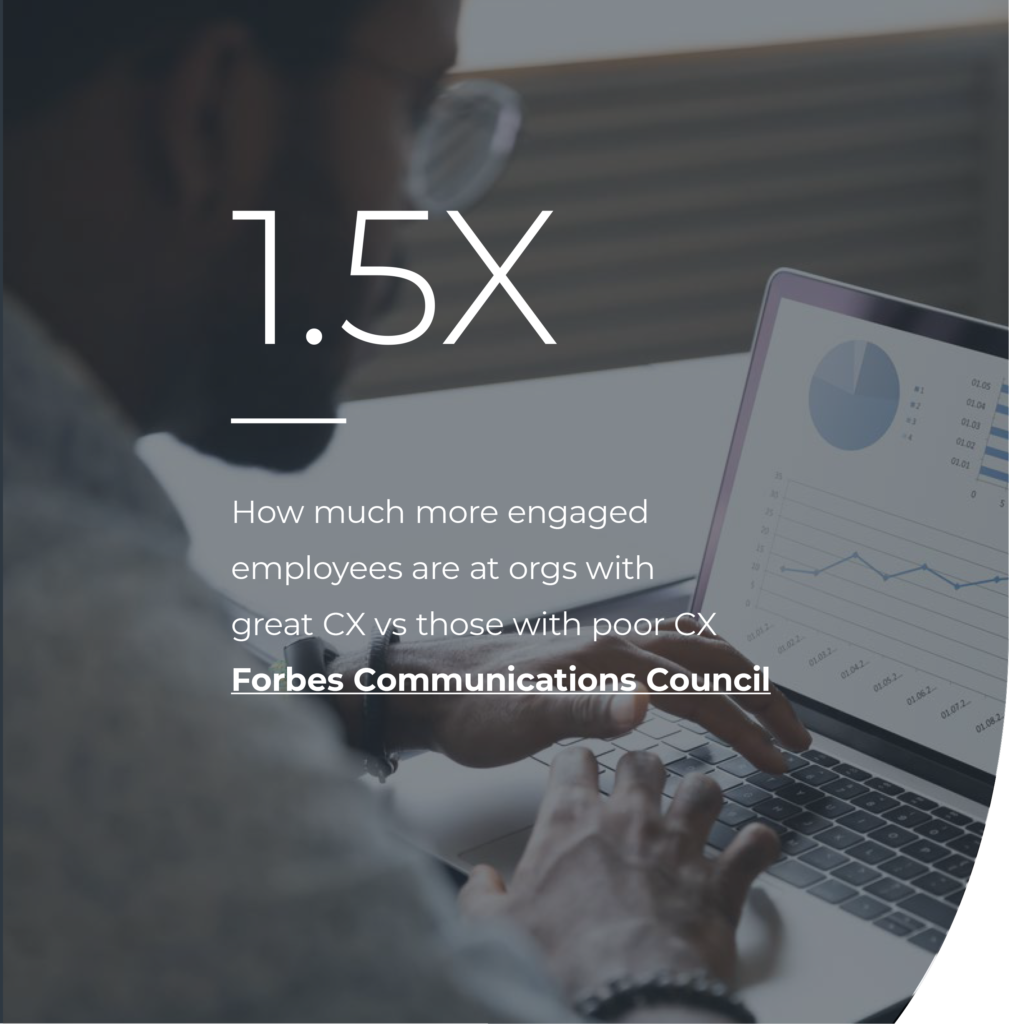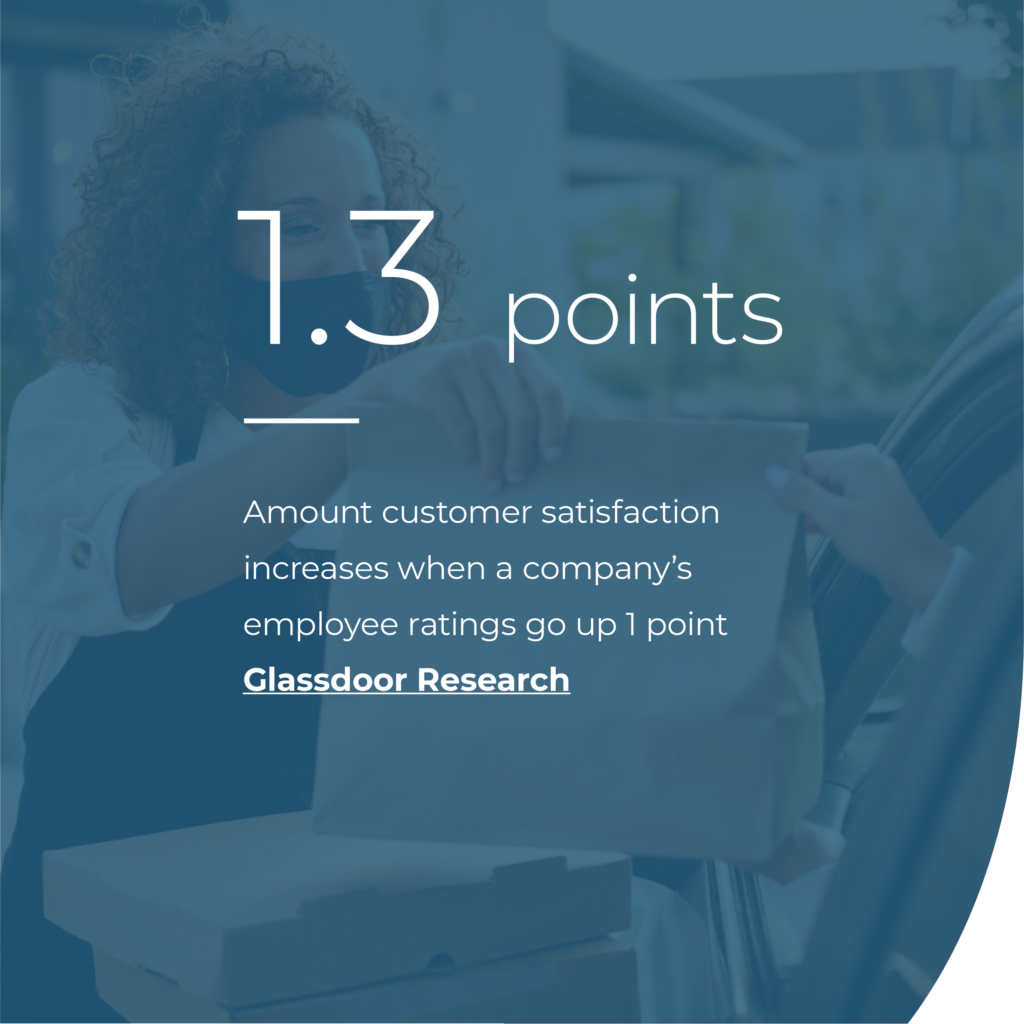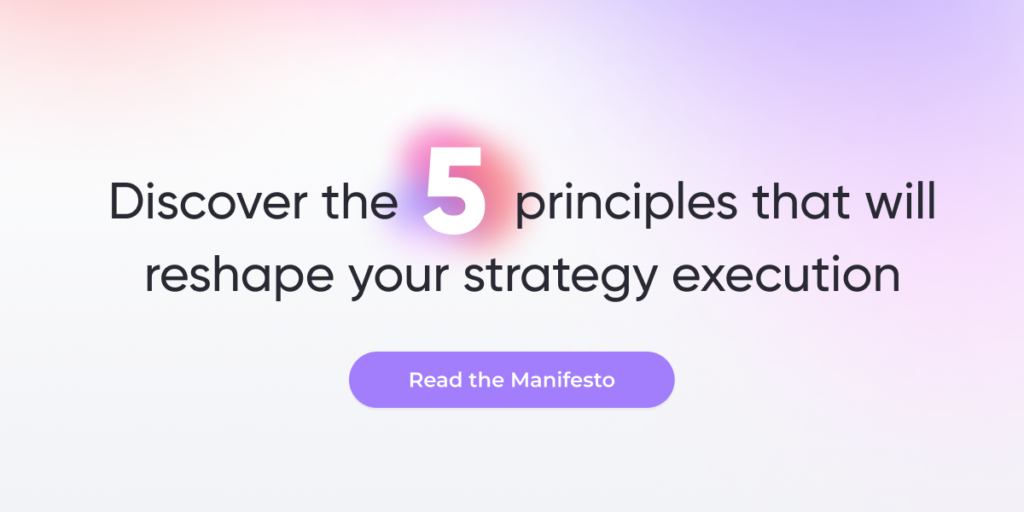Employee Engagement Definition
Employee engagement is a measurement of how committed and invested employees are in their work and the organization’s success. Engagement isn’t just about showing up – it’s about feeling connected, motivated, and passionate about the company’s goals. Organizations can foster this by personalizing communication, providing immediate feedback, and ensuring information is accessible. When these experiences are delivered, employees are empowered to contribute meaningfully, helping drive business outcomes.
Imagine a workplace where employees are not just present but fully invested in the success of the company. When employees are engaged, they bring passion, commitment, and a sense of belonging to their work. This is the transformative power of employee engagement. Research shows that engaged employees are 18% more productive and can boost profitability by 23%. In this article, we’ll show you why employee engagement is the key to achieving these business outcomes and much more.
Key Insights
- Personalized employee communication is key to fostering engagement and ensuring employees feel valued and connected.
- Employee engagement increases productivity by 18% and boosts profitability by 23%, making it a critical business objective.
- Employee recognition and feedback are essential components of an effective employee engagement strategy, helping to retain top talent.
- Organizations that measure employee engagement regularly through employee engagement surveys can proactively address dissatisfaction and drive continuous improvement.
- High employee engagement reduces absenteeism by 78%, showing the impact of targeted employee engagement programs.
- Using employee engagement platforms like Firstup helps companies deliver tailored, relevant communication, enhancing employee satisfaction and overall engagement.
Employee engagement is one of the most important indicators in gauging work satisfaction. Employees today expect consumer-grade digital communication and personalized engagement to stay connected with their work and the organization. Outdated communication methods often fail to meet these expectations. Employees want to be involved in their work, enthusiastic about their organization, have a sense of belonging, and enjoy flexibility in schedules and location.
In 2024, 94% of employees said that fostering a sense of belonging is crucial to workplace success, and yet 20% of workers still report feeling disconnected. Loneliness in the workplace has a measurable impact, costing businesses $154 billion annually due to absenteeism caused by stress-related factors.
Despite employee engagement being viewed as positive company-wide, Gallup data shows that only 23% of employees were engaged at work in 2024, down from 39% in 2021.
Low employee engagement can be caused by several factors including lack of recognition by managers, poor company communication, and not having a better understanding of the mission of the company and engagement efforts. More than ever, employee engagement is a strategic business objective because engaged employees lead to long-term employee retention, higher employee performance, improved quality of work, and organizational success.

What is employee engagement?
Employee engagement is more than just a measure of job satisfaction; it is the deep emotional connection and commitment an employee feels toward their organization’s mission, values, and goals. True engagement arises when employees are not only passionate about their work but are also empowered through meaningful communication and personalized experiences. Modern engagement strategies focus on delivering hyper-personalized content that resonates with each individual’s role, preferences, and timing, ensuring that employees feel informed and valued.
When engagement is high, employees are more than just workers—they become active supporters of the company’s vision, contributing to a culture of innovation and success.
Disengaged employees, however, can pose a risk, doing only the minimum required or even negatively impacting the company’s productivity and morale. By focusing on the complete employee journey—from recruitment and onboarding to recognition and career development—organizations can create an environment where engagement is nurtured continuously and aligns with long-term business outcomes.
Employee engagement has also become synonymous with concepts like employee satisfaction and the employee experience, which is more about the complete employee journey from hiring, employee recognition, to when they leave their job.

Why is employee engagement so important?
For engaged employees who are happy and completely committed to their work, it’s more than just a paycheck—it is the dedication towards their employers and role that makes them passionate, which is often reflected in business success and employee engagement.
If you’ve been wondering why employee engagement is important and how to improve it, start with employee communication and personalization. Personalized, hyper-relevant communication ensures employees feel connected, engaged, and valued. Clear and tailored communication builds strong relationships, driving higher productivity rates. Companies that offer precise, personalized communication quickly build trust among employees.
Often, companies miss the core issues related to employee engagement because executives assume an engaged workforce is directly linked to salary and compensation.
Most leaders figure employees leave due to a lack of promotional opportunities or the lure of a new job package elsewhere. However, connection, communication, and engagement are the three most critical aspects for the growth of organizations. Modern studies highlight the importance of employee trust, relationships with management, and personalization as the key drivers of engagement, not simply compensation.
Of these factors, cultivating work relationships through clear and personalized communication is the core of improving employee engagement outcomes. The shift toward personalization in employee communication ensures each individual feels supported, which translates into better engagement and overall business success.

Significance of employee engagement
When employees are engaged, they are more likely to invest in their work, which leads to higher performance and productivity. Firstup’s data-driven personalization approach enhances productivity by delivering tailored communication that resonates with employees’ specific needs, driving deeper engagement.

In 2024, companies with highly engaged employees were found to be 24% more profitable than those with lower engagement levels . Similarly, disengaged employees cost organizations an estimated $8.9 trillion per year worldwide, annually in lost productivity.
Glassdoor research has shown that a 1-point increase in company rating correlates with a 1.3-point increase in customer satisfaction, underscoring the connection between employee engagement and business outcomes. Organizations with higher employee engagement also report 78% lower absenteeism rates and 23% higher profitability.

Benefits of employee engagement
Employee retention

Human resources leaders are increasingly focused on improving employee engagement initiatives to enhance retention, one of the key reasons for prioritizing engagement. Organizations with high employee engagement reduce turnover by 21%, as disengaged employees are a major contributor to high employee turnover.
Addressing common communication pain points like scattered messages, leadership detachment, and lack of personalized communication is critical for improving engagement. Disengaged employees often feel disconnected from company leadership, which leads to reduced loyalty and higher attrition rates.
Engaging employees through clear, consistent, and personalized communication helps retain top talent by creating a sense of belonging and purpose. According to the APA, 94% of employees who feel heard and valued are more likely to stay with the organization, helping drive business outcomes.
Employee productivity
Engaged employees are not only more motivated but also more productive. When communication is clear and leadership is visibly involved, employees understand their roles and expectations better, leading to more consistent productivity.
According to Gallup, highly engaged teams are 18% more productive than disengaged teams. Engaged employees are more invested in their work, while disengaged employees might be doing the bare minimum.

Increased profitability
Highly engaged teams show 23% greater profitability, according to Gallup. If that isn’t enough to encourage leadership to see the ROI on and implement employee engagement strategies, we’re not sure what is! Addressing communication challenges, such as leadership detachment and lack of message personalization, fosters engagement, which in turn enhances profitability.
Less burnout and better mental wellness
Burnout is a growing issue in today’s workforce, exacerbated by poor communication and unclear leadership involvement. 77% of workers report experiencing work-related stress in the last month, with 40% of workers describing their mental health at work as ‘poor’ highlighting the urgent need for businesses to address employee well-being. Implementing a workplace wellness program that emphasizes engagement through consistent, personalized communication can significantly reduce burnout and improve employee mental health, contributing to a stronger employee experience overall.
Reduction in absenteeism
Absenteeism, when employees take more time off than expected, can indicate a lack of engagement. Frequent absenteeism is often linked to feelings of isolation, unclear communication from leadership, or feeling undervalued. Organizations that improve engagement through clear, personalized communication can expect a reduction in absenteeism, leading to fewer disruptions and improved overall productivity. Gallup reports that highly engaged teams have 78% lower absenteeism.
Firstup allows us to make it happen
Levels of employee engagement
Employee engagement measures how employee feel about their entire organization. Based on their perceptions of their workplace, employee engagement profiles are categorized into four main groups.
Highly engaged employees
Highly engaged employees hold very favorable opinions of their place of work. When employees feel connected to their teams, love their jobs, and have positive feelings about your organization, they’re going to want to stay and put in extra effort to help the organization succeed. These “brand advocates” speak highly of their company to family and friends. They encourage other employees around them to do their best, leading to higher employee engagement amongst the entire team.
Moderately engaged employees
Moderately engaged employees see their organization in a moderately favorable light. They like their company but see opportunities for improvement. These employees are less likely to ask for more responsibilities and may underperform. There is something about the organization or their job that holds them back from full engagement.
Barely engaged employees
Barely engaged employees feel indifferent toward their place of employment. They usually lack motivation for their position and will only do as much as they can to get by—sometimes less. Companies that don’t work at maintaining employee engagement may see employees researching other jobs and are a high turnover risk.
Disengaged employees
Disengaged employees have a negative opinion of their place of work. They are disconnected from the mission, goals, and future of the organization. They lack commitment to their position and responsibilities. It’s important to understand how to handle disengaged employees so that their negative perceptions don’t impact the productivity of employees around them.
This variation of the hierarchy reflects employee engagement level as determined by how well their needs are being met.
How to improve employee engagement

If you’re in HR, you must create an environment that encourages employees to naturally want to be involved in and care deeply about their work. If you want high levels of involvement, motivation, trust, commitment, and empowerment, invest your efforts in improving employee communication.
For large companies, ensuring employees are aligned with the changing priorities of the business is also vital. This is where platforms like Firstup come into play. By automating and personalizing communications, platforms like Firstup ensure that messages reach the right employee at the right time, delivering hyper-relevant content that resonates with their specific needs. This not only enhances engagement but also streamlines communication processes across the organization. By integrating communication tools that tailor content to the right employees, organizations can enhance both efficiency and engagement, creating a more connected, motivated workforce.
“Don’t lose sight of the value of communication. It’s not a “nice to have,” it’s a “need to have.” It’s in the bloodstream of every business objective, every element of a mission statement or core value. Be thoughtful and thorough about how you approach it, both editorially and technically and your organization will benefit.”
— Paul Baltes, Director of Communications at Nebraska Medicine
Importance of effective communication in the workplace
Encouraging proper employee communication is key to connecting employees with your company. Intelligent content recommendations and multi-channel communication strategies are now critical for delivering the right message to the right employees. By ensuring that content is not only personalized but also shared through various channels, such as email, mobile apps, chat applications, or intranets, you can create a more connected and informed workforce.
With effective communication, employees start to identify with the company’s vision, values, and goals. They become enthusiastic about their roles and more engaged in every aspect of their work. This strategy should extend to your hybrid workforce or employees in the field, as they are the most vulnerable to feeling disconnected from the company.
If a large part of your workforce does not come into a central office every day and instead 1) works remotely from home, or 2) spends lots of time in the field, multi-channel communication and intelligent content delivery become crucial. These tools ensure that your communication and employee engagement strategy reaches all groups, no matter where they are.
Learn the 5 steps you can take at your organization to increase engagement and improve communication satisfaction, regardless of the location of your employees
Using communication to improve employee engagement
When you improve employee engagement, you improve business outcomes and therefore increase your value as a human resources professional.Here are some key steps teams can take to drive employee engagement strategies:
- Develop clear internal lines of communication and execute the strategy effectively within the company.
- Enable and promote better organization transparency through communication.
- Effectively communicate business plans and strategies for every member of the team.
- Encourage open lines of communication within the company between employees.
- Use an engagement surveys to get the inside scoop on how employees are feeling.
- Recognize the efforts made by employees on various grounds and make employees feel valued.
To truly elevate employee engagement, consider using a workforce communication platform like Firstup to integrate communication channels. These platforms can target, personalize, and measure engagement efforts, ensuring that the right message reaches the right employees at the right time. Automated, personalized communication can help employees stay informed, engaged, and aligned with the company’s vision and goals.
If employees don’t have access to relevant, accurate, and engaging information, it’s difficult for them to perform at their best—let alone feel excited about their work. Clear, timely communication empowers employees to stay focused and productive.

Communication is also key to setting clear expectations. When employees lack guidelines about what’s expected of them, they won’t know precisely what they need to do, or by when. Personalized communication tools ensure that expectations are clear, fostering mutual respect, prioritizing tasks, and helping employees plan their workdays efficiently.
Encouraging proper employee communication can build a strong bond between your company and your employees and drive employee engagement. With proper communication, employees start to identify themselves with the company’s vision, values, and goals. They are then enthusiastic about doing better and becoming more engaged in every aspect of their jobs.
Lastly, start truly listening to feedback from your workforce. Use tools like real-time analytics and feedback platforms to gather essential conversations about employee engagement and company culture. Through employee listening, HR professionals to respond proactively and keep employees engaged and aligned with organizational goals.
Employee engagement at leading companies
As companies strive to create more engaging workplaces, innovative solutions are reshaping how they connect with their employees. Nebraska Medicine, Phillips 66, and Grainger are leading the charge by adopting modern communication platforms that cater to the unique needs of their diverse workforces. By focusing on timely, relevant, and multi-channel messaging, these organizations have not only enhanced employee engagement but also strengthened their operational performance and overall employee experience.
Nebraska Medicine – connecting with the frontline workforce
Nebraska Medicine, one of the state’s leading academic health systems, faced the challenge of reaching its diverse, largely deskless workforce with timely and personalized communication. With many employees lacking regular access to email or computers, the organization turned to Firstup’s intelligent communication platform to modernize its digital employee experience. “We want to give people as many tools as we can to build engagement,” said Director of Communications Paul Baltes, highlighting their commitment to enhancing two-way communication and engagement across the organization.
By focusing on personalized, multi-channel communication, particularly for frontline staff, Nebraska Medicine aligned with employee engagement best practices. Through Firstup, they’ve created a more connected, engaged workforce, improving both the employee experience and operational outcomes.
Philipps 66 – personalized messaging at scale
Phillips 66, a leading energy manufacturing and logistics company, faced the challenge of engaging over 12,000 employees working across various time zones and shifts. Many of these employees operate outside traditional office environments, making it difficult to deliver timely and relevant communication. Initially, company-wide emails were sent at fixed times, but messages often missed the mark, getting lost in the flood of digital noise.
To solve this, Phillips 66 turned to Firstup’s intelligent content delivery platform, utilizing features like Engagement Boost. This machine-learning tool delivers personalized messages at the optimal time for each employee, drastically improving engagement. In some locations, interaction rates doubled. Laurie Madden, Senior Advisor at Phillips 66, shared, “By allowing the platform to decide the right time and place for notifications, our team saw results soar—sometimes more than double our usual engagement rates.”
By embracing personalized communication and reducing digital fatigue, Phillips 66 has aligned with employee engagement best practices. Their approach ensures that every employee, no matter their location or schedule, receives messages that truly resonate, strengthening connections and driving engagement across the organization.
Grainger – omni-channel intelligent communication
Grainger, a global industrial supply company, faced the challenge of engaging a dispersed workforce, with many employees working in the field or in warehouse environments. Reaching these deskless employees with critical information in a timely and accessible way was crucial for the company, as traditional communication methods left many feeling disconnected, impacting engagement and productivity.
To solve this, Grainger implemented Firstup’s intelligent communication platform, leveraging multi-channel messaging and a mobile app to reach employees wherever they are. This enabled the company to deliver personalized, real-time updates, improving connectivity across its workforce with engagement rates that were as much as 15 times better. As Brodie Bertrand, VP of Communications and Public Affairs, shared, “We definitely see that Firstup users are more engaged.” The platform’s ability to deliver timely, relevant information in a mobile-friendly format ensures that even remote and deskless employees stay connected and engaged.
This approach also embodies employee engagement best practices, focusing on accessibility, personalization, and timely communication. By prioritizing these elements, Grainger has strengthened employee engagement, building a more connected, motivated workforce aligned with the company’s goals.
The value of the digital employee experience
Finally, if you want to create effective employee engagement and communication as HR leaders, you need to show the value of the employee experience.
Firstup’s platform enhances the employee experience by seamlessly integrating communication channels, ensuring that employees receive relevant information across email, mobile apps, intranets, and more. By leveraging data analytics, Firstup continuously optimizes engagement strategies, allowing organizations to deliver hyper-personalized content at the right time to keep employees connected and informed.
The employee experience affects everything from employee engagement and productivity to the customer experience.
How can you prove to the c-suite that the financial performance results will be worth the investment in increasing employee engagement?
We’ve compiled real-world advice from business leaders who transformed their digital employee experience (DEX) by gaining executive buy-in at every step.
Learn how they leveraged employee data and built support across the company to achieve their goal. Plus, get a free roadmap you can use to plan your DEX project.
FAQs
Employee engagement is important because it leads to higher productivity, better employee retention, and improved job satisfaction. Engaged employees are more committed to their work and aligned with company goals, which drives overall business success.
An employee engagement survey is a tool used by organizations to measure how connected and motivated employees feel at work. It collects feedback on areas such as communication, leadership, and workplace culture to improve engagement strategies.
Measuring employee engagement involves using various tools like employee engagement surveys, performance metrics, and feedback platforms to assess motivation, satisfaction, and commitment levels. It helps identify areas that need improvement.
An employee engagement program is a structured initiative designed to boost workplace morale, foster communication, and motivate employees. It includes activities such as recognition programs, career development opportunities, and regular feedback to keep employees engaged.
Common employee engagement survey questions include: “Do you feel valued at work?”, “Do you understand your role in achieving company goals?”, and “How satisfied are you with communication from leadership?”. These questions help measure key engagement factors.
An employee engagement platform helps engage employees by providing personalized communication, real-time feedback tools, and data analytics. It allows organizations to measure engagement, streamline communication, and ensure that employees feel connected and valued.
Employee engagement models are frameworks designed to help organizations understand and improve the factors that drive employee engagement. These models, such as the Gallup Q12 or Aon Hewitt models, provide structured approaches for gathering insights through employee engagement surveys, analyzing data, and addressing areas like communication, recognition, and development. By using employee engagement software and asking targeted employee engagement survey questions, companies can tailor strategies that boost morale and foster a more connected workforce.
Download PDF








